Rumney has a well-deserved reputation as the best sport crag in the Northeast, thanks to its high-quality, single-pitch, bolted climbs at almost every grade. But, did you know that Rumney is also home to a handful of fun, moderate, multi-pitch sport climbs? Here’s a best-of list for almost every grade, along with tips for honing your multi-pitch skills.
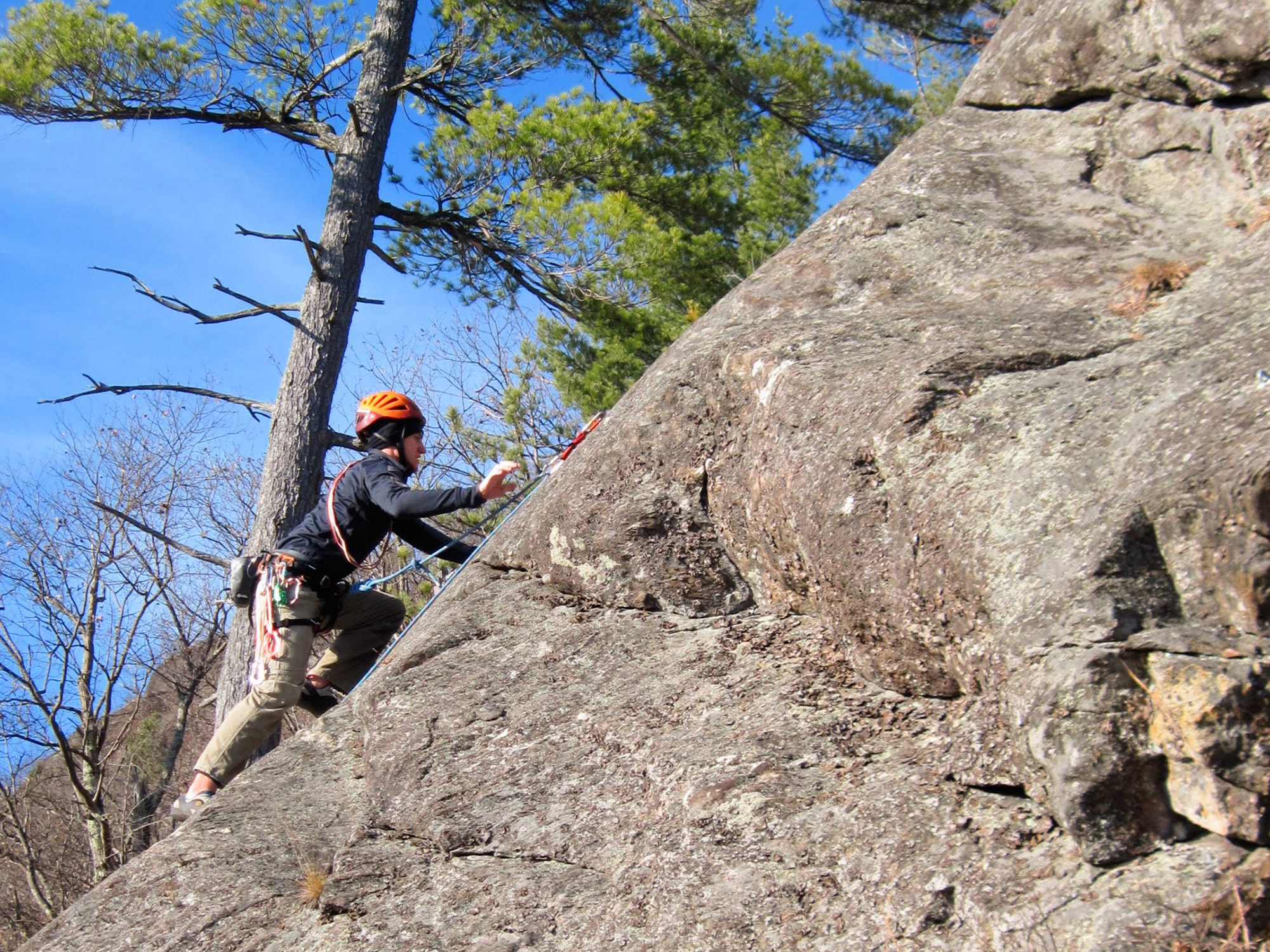
Jimmy Cliff: Clip a Dee Doo Dah, 5.3
Don’t discount this remarkable route because of its modest grade. Clip a Dee Doo Dah delivers two pitches of fun slab climbing on surprisingly sticky stone leading to a cliff top with a breathtaking view of the Baker River. This route is so good, you’ll want to bring your approach shoes, so you can make quick time on the trail back to the base of the route and do it again!
Clip a Dee Doo Dah is well protected and a fantastic climb for newer leaders. With a two-bolt anchor and decent ledge atop the first pitch, it is also a great place for any climber to practice multi-pitch rope management. In particular, carefully consider where you build your master point and put your belay. Putting it too low may lead to exhausted elbows and a messy rope stack as you try to keep up with your partner charging up the route.
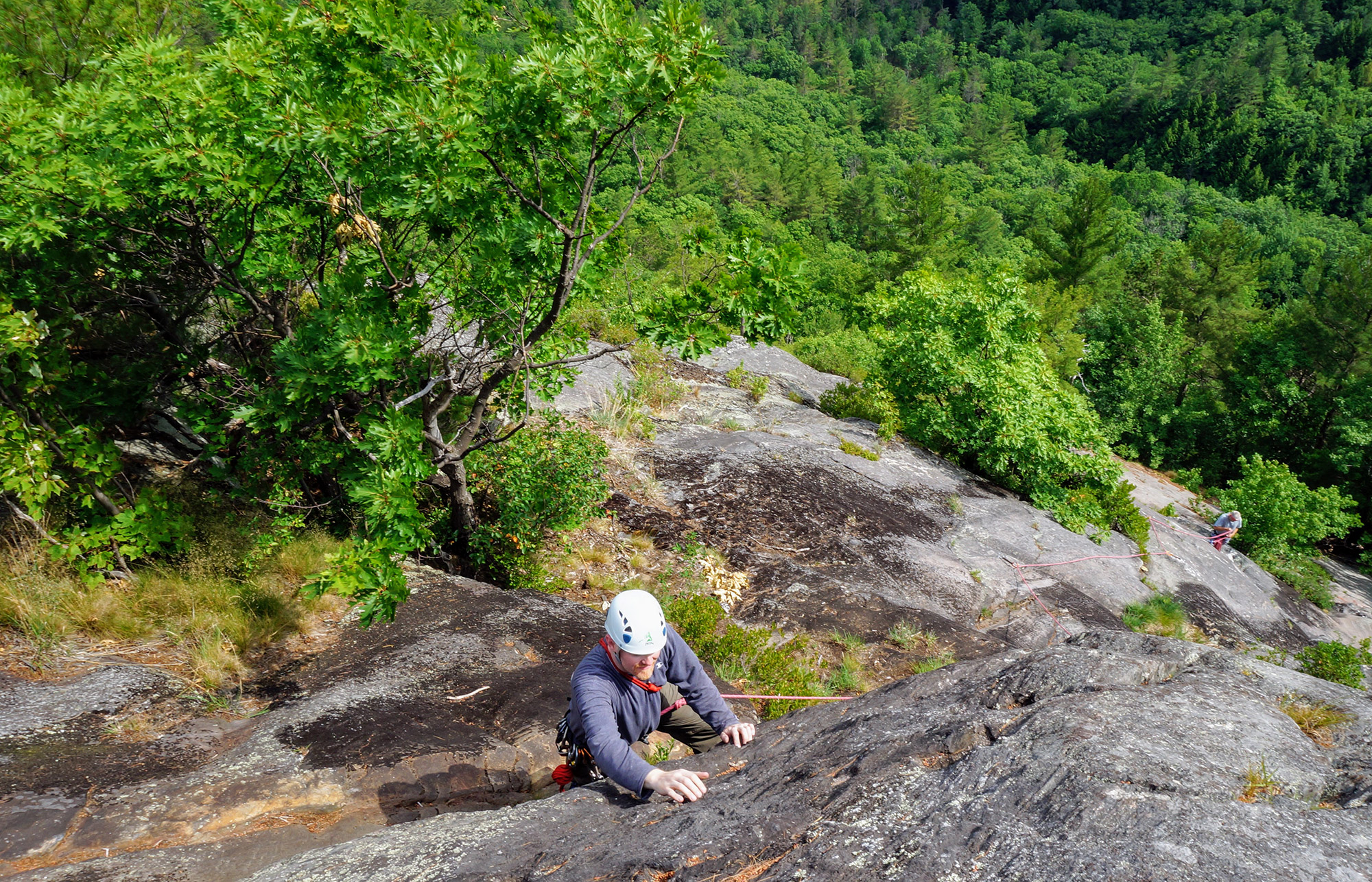
Jimmy Cliff: Lady and the Tramp, 5.4
Immediately to the climber’s right of Clip a Dee Doo Dah is Lady and the Tramp. It features the same stellar rock found on its popular neighbor, but it’s a little bit steeper and has a few bulges, with the most notable one being directly above the belay at the top of pitch one. It, too, is an excellent route for leaders new to multi-pitch climbing.
In terms of skill building, the route presents a great opportunity for recognizing the dangers of falling directly onto the belay. Particularly, watch out for the crux on the second pitch, located just above the first anchor and initially unprotected. Although a fall is unlikely, the consequences are significant. As such, get in the habit of clipping one of the anchor bolts before leaving the belay.
Speaking of belays, Clip a Dee Doo Dah and Lady and the Tramp share an anchor atop the second pitch. So, in case it’s occupied, bring a cordelette, so you can build your anchor on one of the many nearby trees. Bonus points for safely extending the anchor, so you can watch your second climb!

Main Cliff Right: Model Citizen, 5.6
Model Citizen is a great introduction to Rumney’s more vertical multi-pitch climbing. Featuring huge holds and interesting movement, the first pitch leads to a two-bolt anchor on a modestly sized belay ledge. More of the same type of climbing follows on pitch two. In fact, if you have a 70-meter rope, the two pitches can be combined into one monster-long pitch, albeit with the leader only being lowered to the anchor on the top of the first pitch.
A key for this route—and the others that follow—is that the top of the final pitch is not intended to be a belay station. Rather, the leader should build an anchor, clip the rope into it just like on a regular single-pitch sport climb, and then get lowered back to the first-pitch anchor. The second can then clean the route and anchor, before being lowered back to the first-pitch anchor. From there, the parties can do a single-rope rappel to the ground. Have questions about the best way to rappel? Check out tip 2 and the associated video in this goEast article.
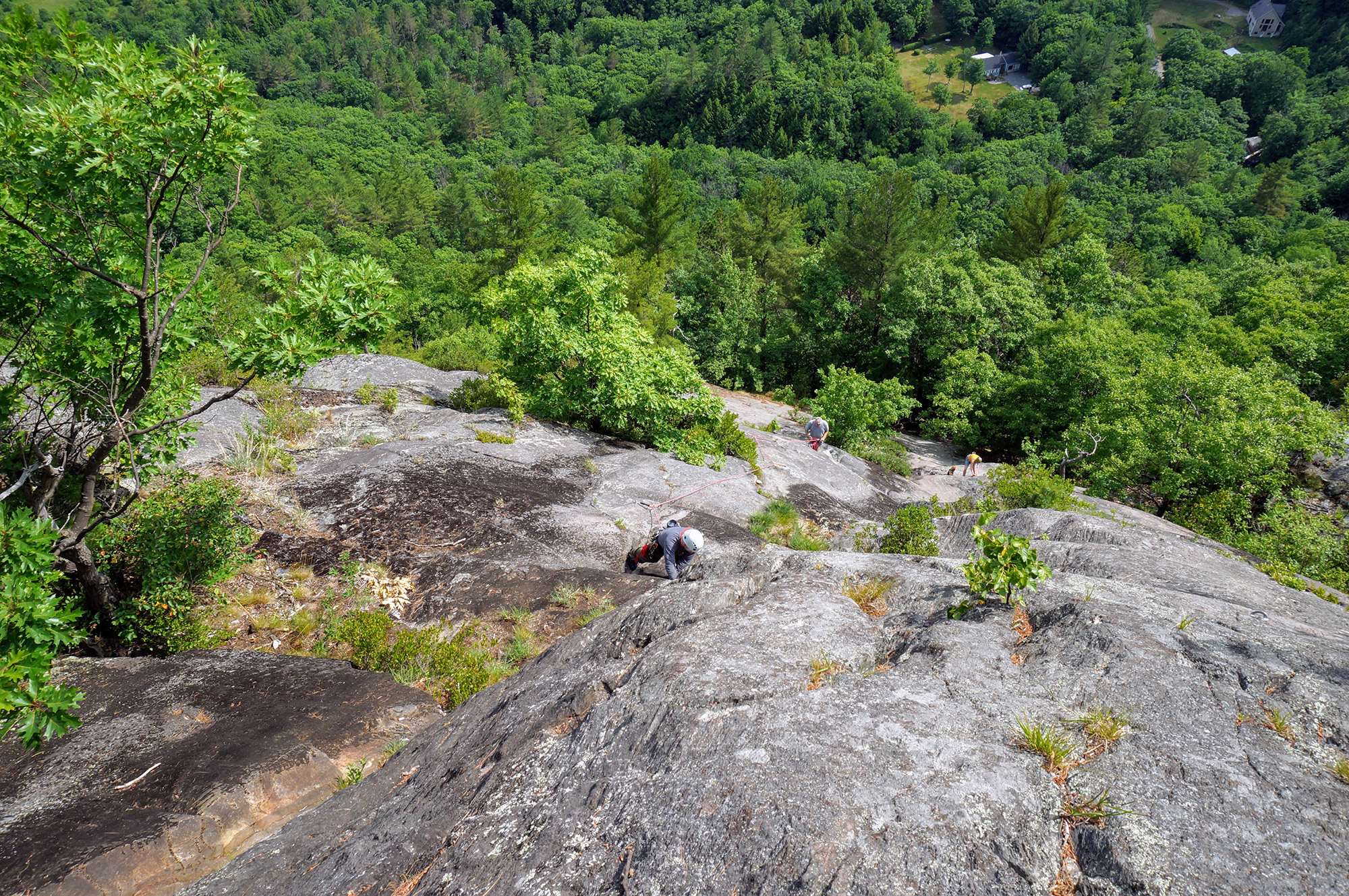
Main Cliff Right: Crowd Pleaser, 5.7
Another fantastic multi-pitch route, Crowd Pleaser begins a few feet to the right of Model Citizen in a left-facing corner. After an awkward first move or two, the route continues on good holds to an initial two-bolt anchor, for those wanting to top-rope the first pitch. Assuming you’re doing both, keep climbing just a little bit higher to the top of the first pitch. Here, there’s another two-bolt anchor with a nice ledge to belay from. The second pitch begins as low-angled slab before turning into fun, exposed climbing on the arete.
Pigtails, otherwise known as ramsheads, have been a popular option for equipping lower-offs in Europe for years. Inexpensive, robust, and easy to use, they are becoming a more common sight at Rumney, thanks to a grant from the American Alpine Club and the Access Fund. And, unlike other top anchors, they are certified and tested for use as a lower-off—a pigtail is rated to 18kN. Plus, they have no moving parts to wear out or rust.
Want to learn more about using the pigtails found at Rumney? Check out this fantastic video the Rumney Climbers Association published.
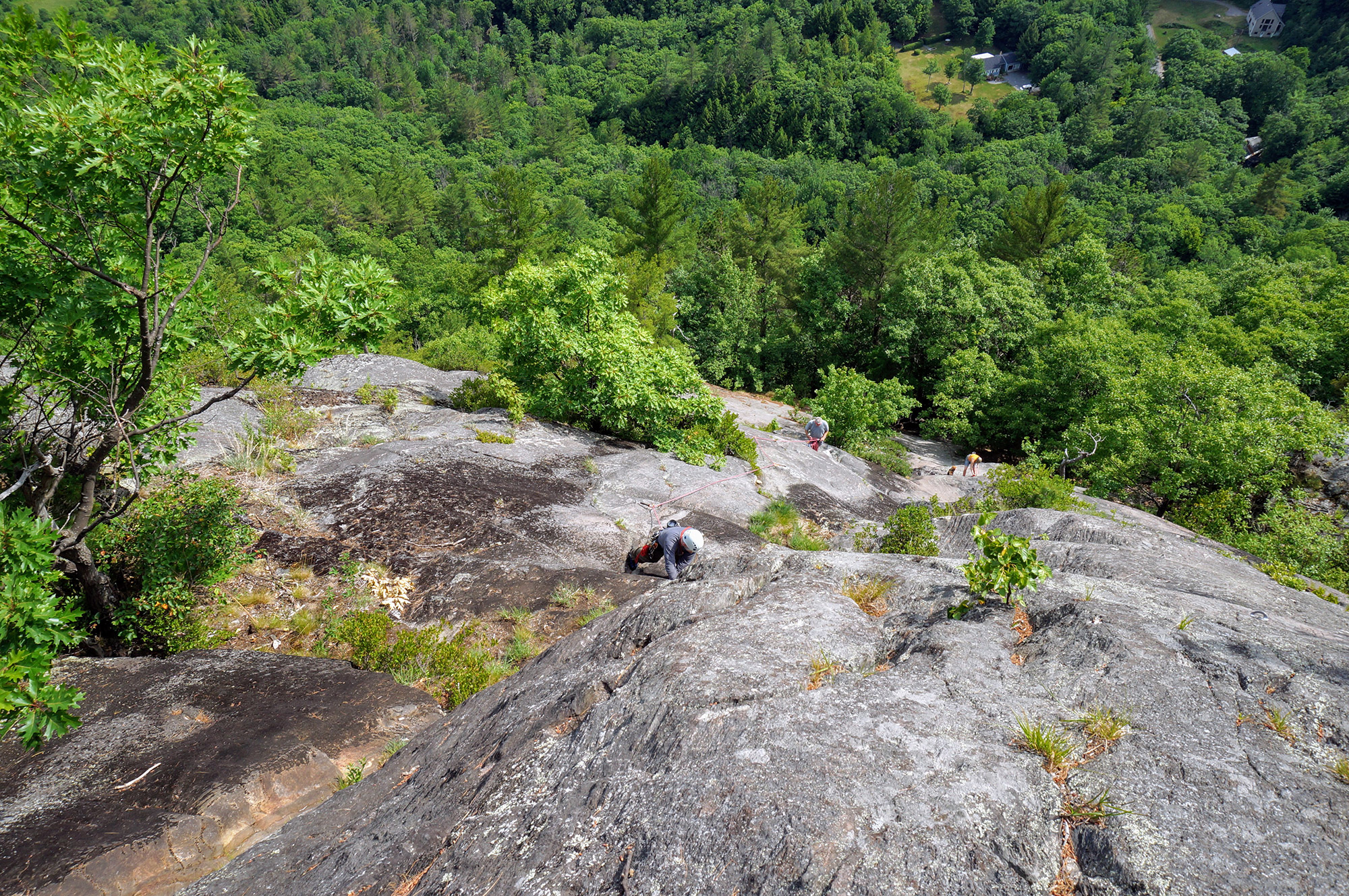
Main Cliff Right: Tipping Point, 5.8
The hardest move on the first pitch of this juggy gem of a route might be the first one. So, consider having your belayer spot you until you make your first clip, or you could face a long tumble down the hill. Tipping Point’s first pitch is filled with dreamy climbing, once you unlock the hidden holds, and it ends at a huge belay ledge. Build an anchor, bring up your second, and then continue up. The crux comes at the top of the second pitch, where the slab turns vertical. Although it can feel challenging compared to the rest of the route, the holds are all there, the climbing is fun, and the position is fantastic.
The anchor on the first pitch is the perfect place to practice using the quad anchor. The quad is our go-to anchor on two-bolt anchors.
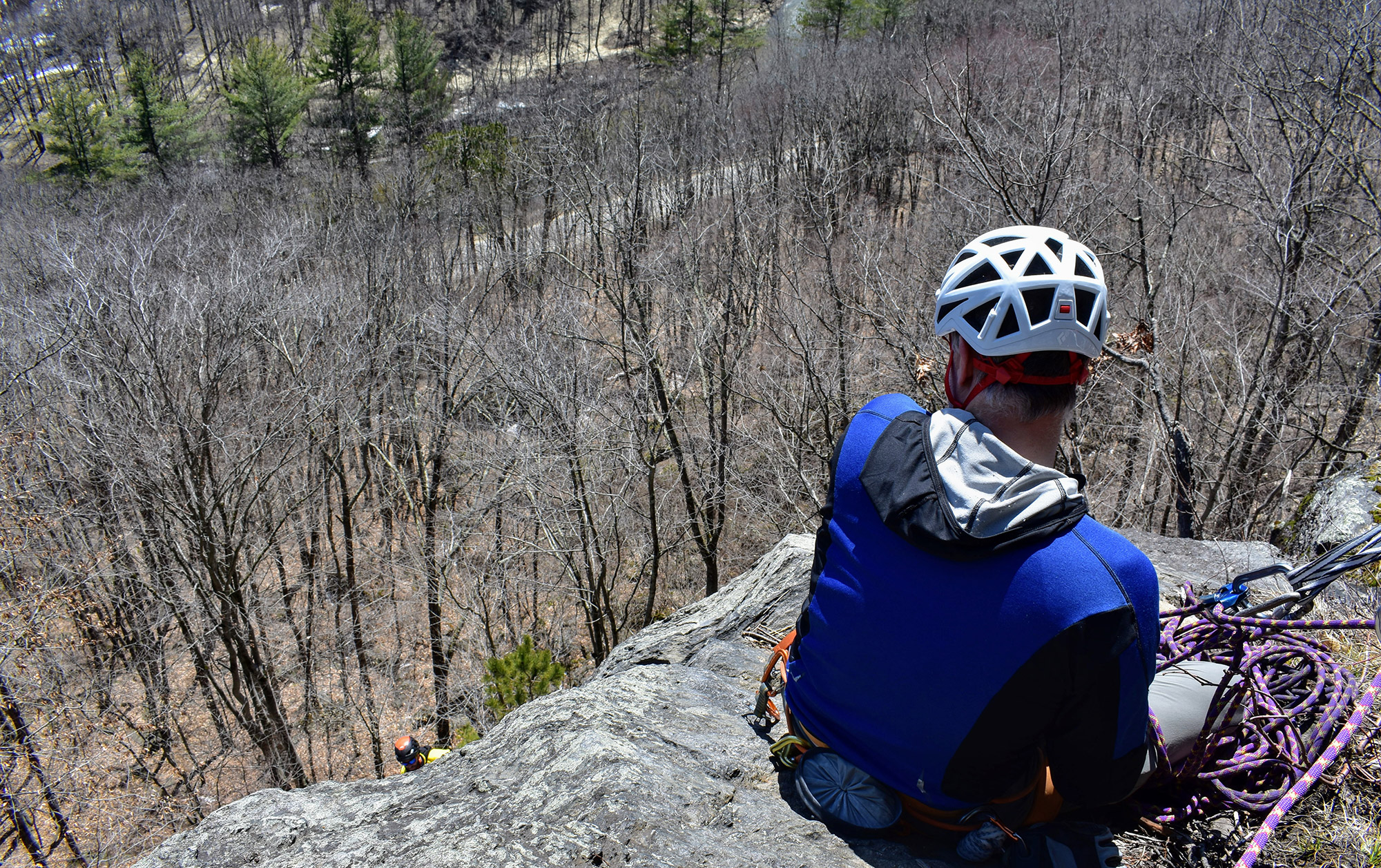
Main Cliff Right: Charity Toad, 5.9
If you’re looking to beat the crowds on Model Citizen, Crowd Pleaser, and Tipping Point, check out Charity Toad. This three-pitch climb is the hardest of the Main Cliff Right’s multi-pitch routes, connecting Charity Case with the final pitch of White Toad via a short traversing pitch. White Toad’s final pitch is airy and very exposed—and definitely worth checking out.
Since you can access several climbs from the top of the first pitch, and the route’s second-pitch traverse crosses at least one more, Charity Toad’s first-pitch belay anchor is a great place to sharpen your route-finding skills. In addition to reading the guidebook, consider taking a screenshot of the route description and map with your smartphone. That way, you’ll have all the beta with you while you’re climbing the route. Of course, if you want to minimize any potential route-finding confusion, just climb the first two pitches of White Toad instead. But, since White Toad’s first pitch only goes on gear, you’ll have to bring your trad rack.
Have you climbed any of aforementioned routes? Tell us which one is your favorite in the comments.
Tim Peck and Doug Martland
Tim and Doug met long ago at the Eastern Mountain Sports in Canton, Massachusetts. Bonding over a love of slick Quincy Quarry granite, White Mountain sufferfests, and scheming up adventures while folding tee-shirts, today Tim and Doug collaborate to write about their favorite outdoor activities and occasionally get nostalgic about tee-shirt tables.
Related Posts
April 12, 2024
Explore Like a Local: The Outdoor Mecca of North Conway, NH
There's a lot to love about this New…
April 3, 2024
5 Things To Do in the Boston Area During Mud Season
Adventure opportunities are abundant…




